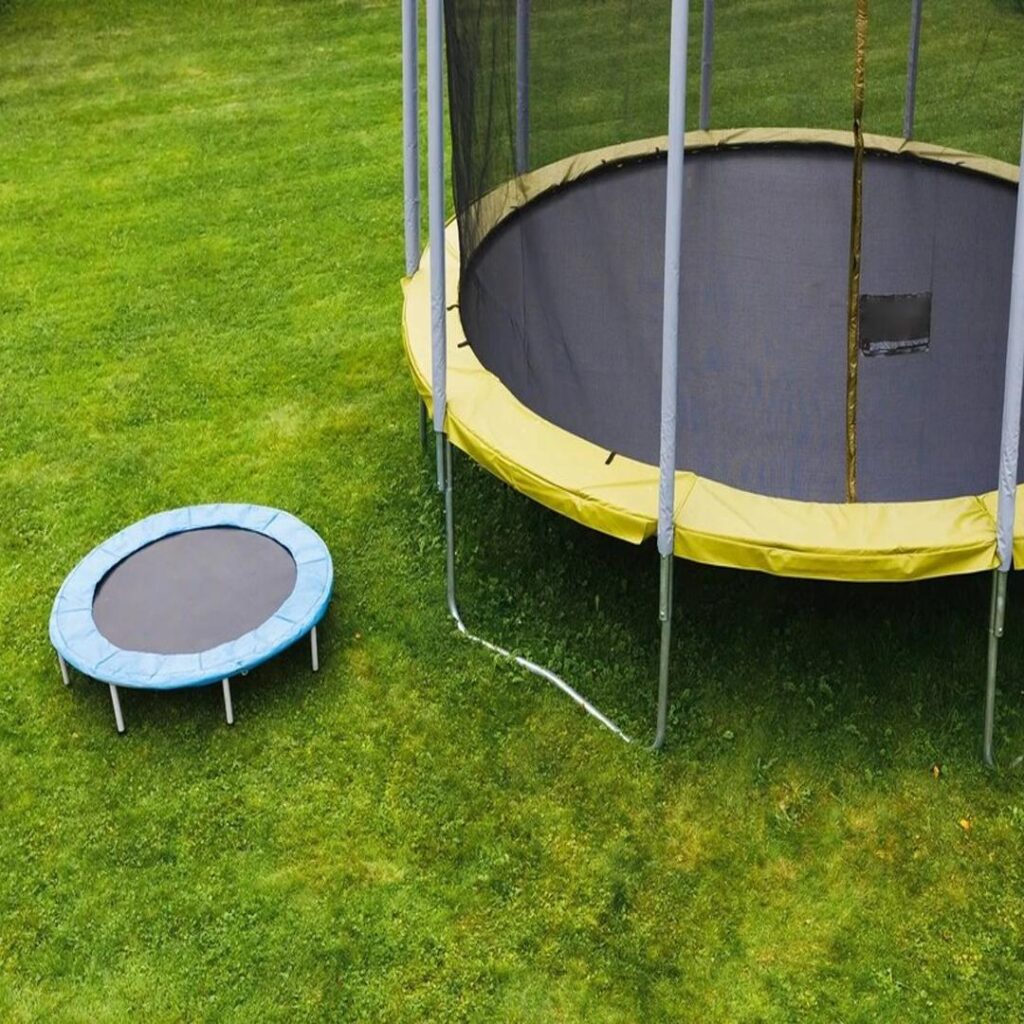
Trampolines have long been a beloved addition to backyards worldwide, offering endless hours of fun, exercise, and airborne thrills for all ages. Beyond the sheer joy of bouncing, trampolines provide significant health benefits, including improved coordination, cardiovascular fitness, and lymphatic circulation. However, the decision to purchase a trampoline comes with a crucial consideration that many first-time buyers may overlook: the shape of the trampoline.
Choosing the right trampoline shape is important as it affects the bounce quality, safety features, and space required. There are four main shapes available: round, rectangular, oval, and square. We’ll help you determine which one best fits your needs, space, and budget. Let’s jump right in and find out which trampoline shape is right for you!
Understanding Different Trampoline Shapes
Choosing the right garden trampoline shape is essential for maximizing both safety and enjoyment. Here, we delve into the various shapes, starting with one of the most popular: the round trampoline.
Round Trampolines
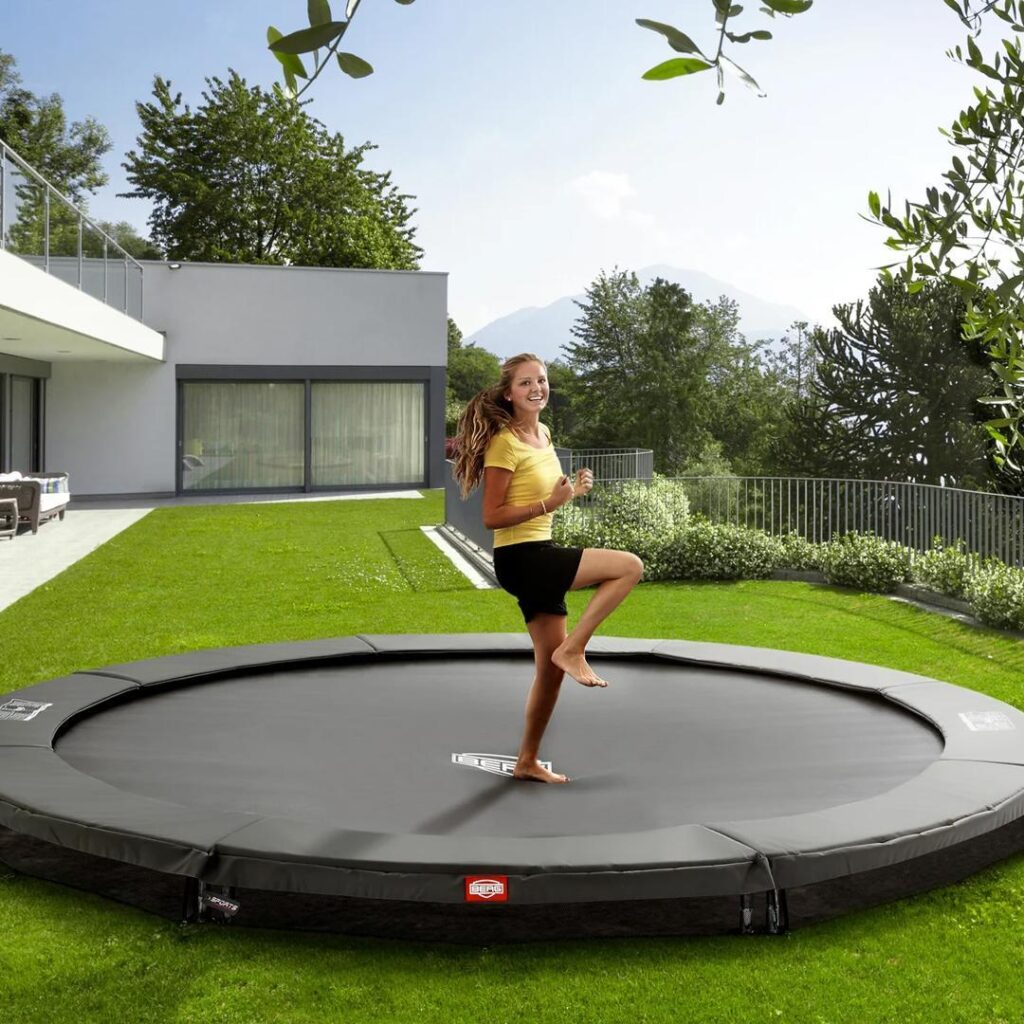
Round trampolines are easily the most recognizable and widely used type of trampoline. Characterized by their circular shape, they are designed to direct the jumper back to the centre with each bounce. This feature makes round trampolines particularly popular among families with younger children.
Pros:
- Safety Features: The centralized bounce mechanism ensures that users are less likely to bounce off to the edges, which can be particularly reassuring for parents. This makes the round trampoline a safer option, especially for less experienced bouncers.
- Affordability: Round trampolines are generally more budget-friendly than other shapes, making them a great entry-level option for those new to trampolining.
- Availability: Due to their popularity, round trampolines are readily available from a variety of manufacturers, offering a wide range of sizes and accessory options.
Cons:
- Limited Bounce Area: The circular design means that the usable bounce area is somewhat restricted compared to rectangular trampolines. This can be a drawback for those looking to perform flips and other advanced tricks.
- Less Suitable for Advanced Tricks: The nature of the bounce towards the centre makes round trampolines less ideal for gymnasts or other advanced users who need more control over where they land to safely perform complex manoeuvres.
Rectangular Trampolines
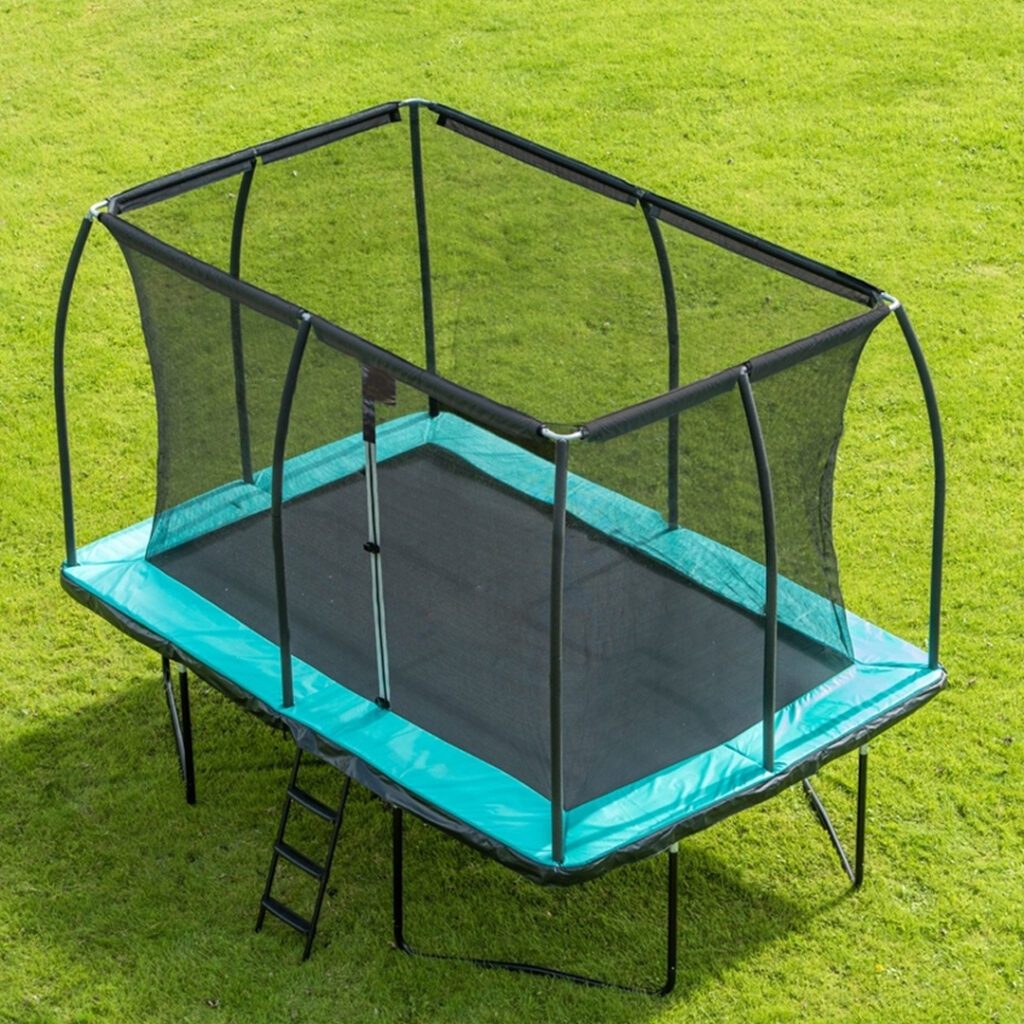
Rectangular trampolines offer a distinct aesthetic and functional edge, typically favoured in professional sports and training environments. Their straight edges and corners allow for a more even distribution of springs, which enhances the bounce quality across the entire surface.
Pros:
- Even Distribution of Springs: This feature allows for a higher, more consistent bounce, making it ideal for athletes and serious trampoline enthusiasts.
- Preferred by Gymnasts: The uniform bounce and larger surface area are perfect for gymnasts, who require precise control and space to perform flips and other routines.
- Professional Bounce: Offers a more robust and controlled bounce, allowing for more advanced manoeuvres and a better overall performance.
Cons:
- Generally More Expensive: The specialized design and construction materials often make rectangular trampolines pricier than their round counterparts.
- Requires More Space: Due to their shape, they take up more space and might not be suitable for smaller yards.
Oval Trampolines
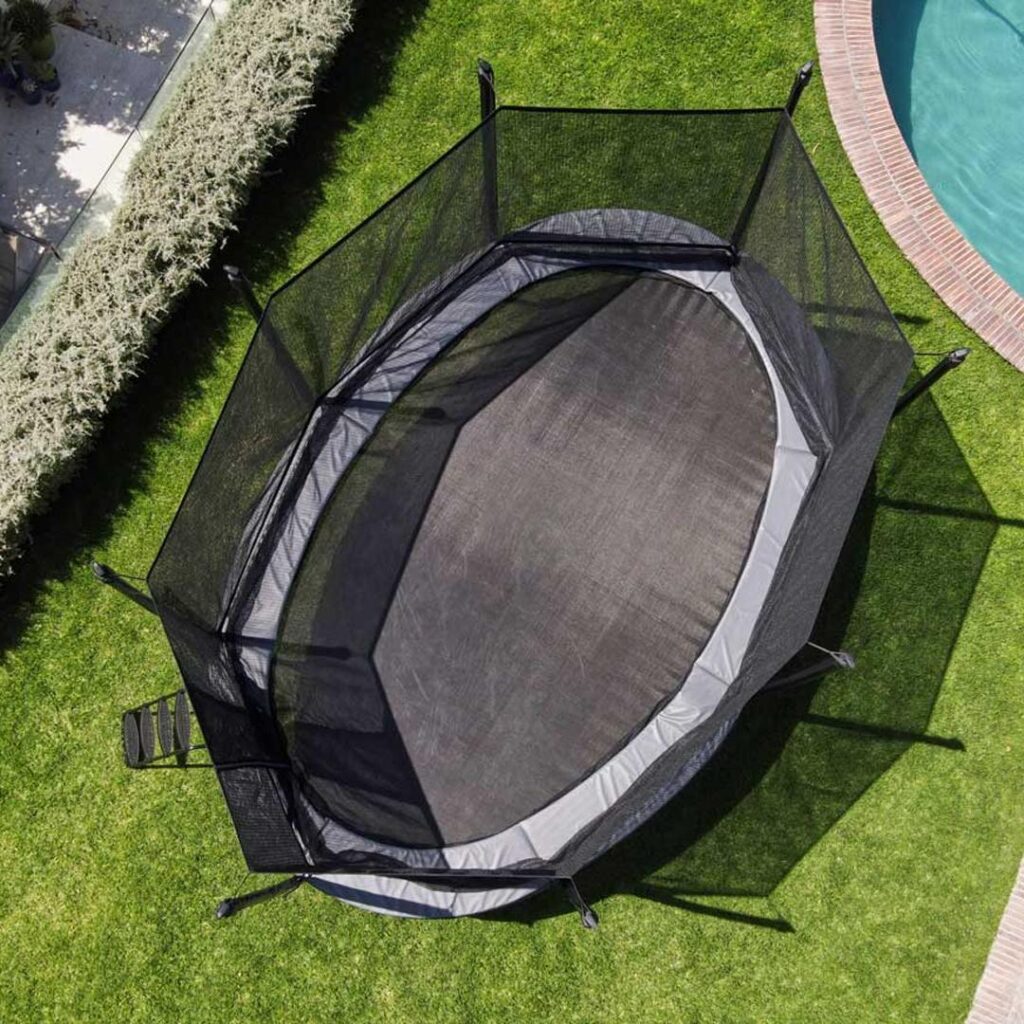
Oval trampolines blend the characteristics of round and rectangular trampolines, providing a long axis for jumping and curved ends that help direct the jumper back towards the centre. This shape offers a generous jumping area with enhanced safety features.
Pros:
- Combines Benefits of Round and Rectangular Shapes: Oval trampolines provide a larger jumping area than round trampolines, while also offering some of the safety benefits of a centralized bounce.
- Good for Families: This shape is ideal for multiple jumpers and offers enough room for safe and fun interaction, making it a favourite among families.
- Versatile Use: Suitable for both casual fun and more serious exercises, accommodating a wide range of activities.
Cons:
- Can Be Pricey: Like rectangular trampolines, oval options can also be more expensive due to their larger size and more complex design.
- Requires More Space Than Round Trampolines: While not as demanding in space as rectangular models, oval trampolines still need more room compared to round trampolines.
Square Trampolines

Square trampolines offer a unique blend of the characteristics found in both round and rectangular trampolines. The equal side lengths and right-angled corners provide a layout that maximizes the jumping area within the confines of a compact footprint, making efficient use of space.
Pros:
- Offers a Large Jumping Surface: The geometric efficiency of the square shape maximizes the usable area within the trampoline, providing a large surface area for jumping.
- Robust Bounce Similar to Rectangular Models: Like rectangular trampolines, square trampolines have an even distribution of springs that provide a strong, consistent bounce. This makes them suitable for performing tricks and more serious trampoline activities.
- Space Efficiency: The square shape fits more easily into corners or restricted spaces, making it a practical choice for those with limited yard space.
Cons:
- Can Be More Expensive: Due to their specialized construction and less common shape, square trampolines often come with a higher price tag than round trampolines.
- Less Common Than Other Shapes: Finding a square trampoline can be more challenging as they are less frequently stocked by retailers compared to the more popular round and rectangular options. This can also limit the availability of parts and accessories.
Factors to Consider When Choosing a Trampoline Shape
Selecting the perfect trampoline involves more than just choosing a shape; it requires a careful evaluation of several key factors that will affect your trampoline’s functionality and enjoyment. Here are some essential considerations:
Space Availability
Before deciding on a trampoline shape, the first step is to assess the amount of space you have in your yard or designated area. Different shapes not only occupy different amounts of space but also have varying space requirements for safe usage (like clearance around the trampoline).
- Measure your available space: Ensure there is enough room for the trampoline itself and additional space around it to accommodate safety features like enclosures.
- Consider the trampoline’s orientation: Some shapes may fit better into certain yard shapes and sizes. For example, rectangular trampolines might suit narrow, long yards, while round ones could be better for smaller, more symmetrical spaces.
User Needs
Understanding who will be using the trampoline most frequently helps in choosing the most suitable shape.
- Children: Safety and control are paramount. Round trampolines are excellent as they naturally redirect the jumper to the centre.
- Adults: Depending on usage, adults might prefer larger trampolines (rectangular or oval) which offer more room and a better bounce for exercise routines.
- Athletes: Gymnasts and other sports enthusiasts may require rectangular trampolines for the even, powerful bounce needed to perform advanced manoeuvres.
- Family Use: If the trampoline is to be used by multiple users at once, oval or square trampolines might be ideal due to their larger and more evenly distributed jumping area.
Safety Features
Safety should never be compromised, regardless of the trampoline shape.
- Enclosure Nets: Vital for preventing falls off the trampoline, enclosure nets are a must, especially if children will be using it.
- Padded Frames and Spring Covers: These protect users from injuries related to impacts with the frame or springs and are essential across all trampoline types.
- Quality of Build: Ensure that the trampoline you choose meets or exceeds safety standards for maximum durability and safety.
Budget
The cost of a trampoline can vary significantly based on its shape due to differences in design complexity and material requirements.
- Round trampolines tend to be more affordable, making them a great choice for budget-conscious buyers.
- Rectangular and square trampolines are usually on the higher end of the price spectrum due to their larger size and the higher costs associated with their construction.
- Oval trampolines strike a balance between cost and functionality, often priced mid-range.
Considering these factors not only ensures that you select the right trampoline for your space and users but also helps in managing expectations regarding safety and budget.
Popular Trampoline Models for Each Shape
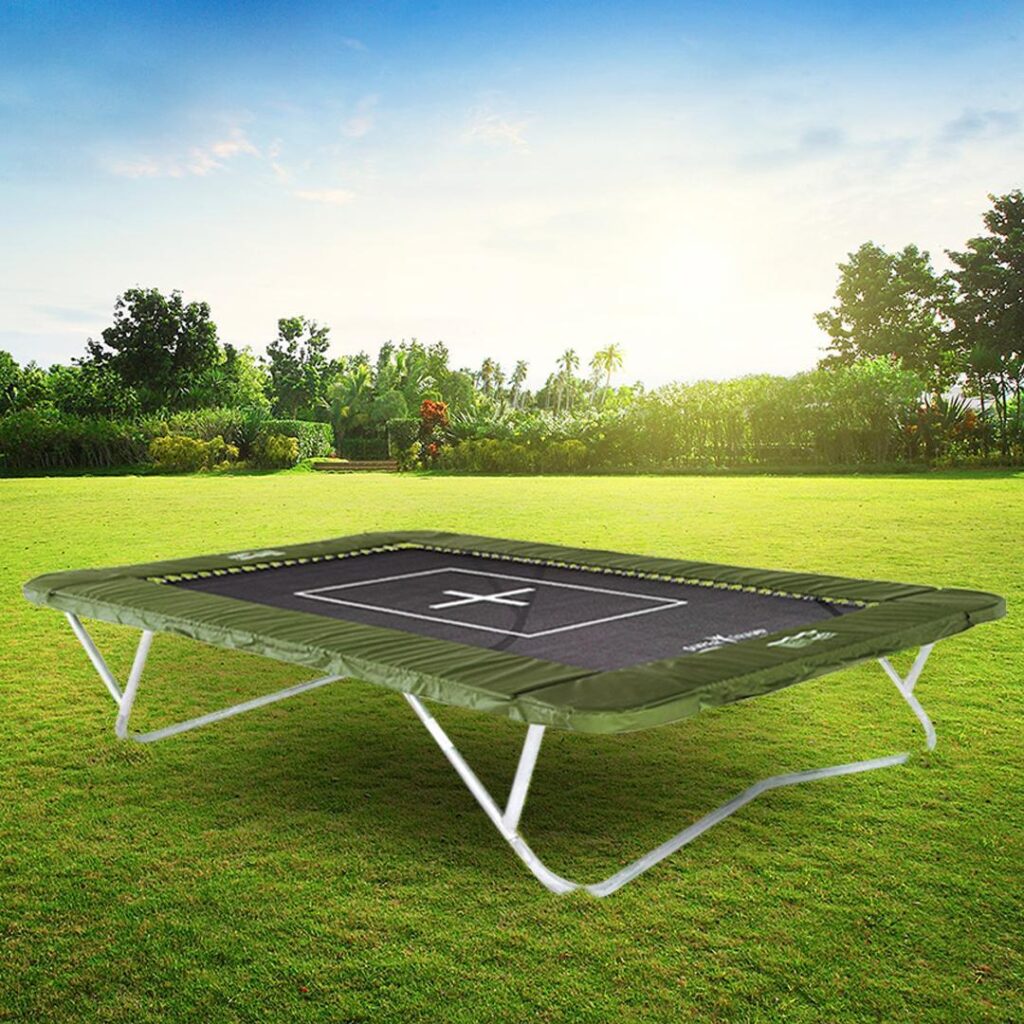
Choosing the right trampoline brand and model is just as important as selecting the shape. Here are a few popular models for each trampoline shape, along with their specific features:
Round Trampolines
1. SuperTramp Orbit 12ft In-ground Round Trampoline:
- Features: This in-ground trampoline integrates smoothly into your garden, providing an expansive jumping surface without blocking views. It features the AkroSpring system for a powerful and quiet bounce, fire-resistant PVC for safety in varying temperatures, and rust-resistant frames for durability. The trampoline is designed for easy and tool-free assembly with the AkroClick system and is constructed with antiseptic and non-toxic materials for a safe jumping environment.
- Availability: Ideal for medium to large gardens, the 12ft Orbit trampoline ensures easy access and an unobtrusive setup, blending aesthetics with functionality.
Rectangular Trampolines
2. SuperTramp Trampolines 11 x 8-Foot Rectangular Trampoline:
- Features: Known for their professional-grade quality, Supertramp Trampolines offer superior bounce and durability. This model features heavy-duty frame construction, high-tensile springs, and a spacious jumping area, making it ideal for gymnasts and advanced users.
- Performance: The rectangular shape provides a more consistent bounce across the entire surface, allowing for precise control and advanced tricks.
Oval Trampolines
3. Springfree Trampoline 13-Foot Oval Trampoline:
- Features: Spring-free trampolines are renowned for their innovative design, which eliminates traditional springs and frames to reduce the risk of injury. The oval shape offers a large jumping area and the FlexiNet enclosure provides a safe and responsive bounce.
- Safety: Spring-free trampolines are engineered with safety as a top priority, with features such as SoftEdge mat technology and FlexiNet enclosure designed to minimize impact points.
Square Trampolines
4. Vuly Thunder Pro Large Square Trampoline:
- Features: The Vuly Thunder Pro is a premium-grade square trampoline known for its heavy-duty construction, including a strong frame and resilient mat material. It also features a unique leaf spring system for a smoother, more controlled bounce.
- Durability: With its robust build quality and weather-resistant materials, the Vuly Thunder Pro is built to withstand years of outdoor use, making it a popular choice for families seeking a long-term investment in backyard fun.
Do your research before buying a trampoline, as each model offers unique benefits for different user needs.
Final Thoughts
Choosing the right trampoline shape is crucial for balancing safety, space, and enjoyment. Consider the specific needs of your family and the features of different models to ensure you make the best investment. Happy bouncing!


